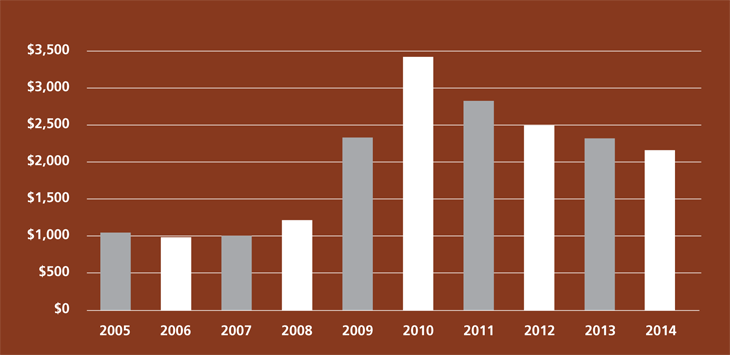2014 Annual Report
IV. FDIC Budget and Spending
CORPORATE OPERATING BUDGET
The FDIC segregates its corporate operating budget and expenses into two discrete components: ongoing operations and receivership funding. The receivership funding component represents expenses resulting from financial institution failures and is, therefore, largely driven by external forces, while the ongoing operations component accounts for all other operating expenses and tends to be more controllable and estimable. Over the past decade, the FDIC’s expenditures have varied in response to workload. From 2008-2010, expenditures rose substantially, largely due to increasing resolution and receivership activity and the oversight of more problem institutions. Since 2010 these activities and their associated expenditures have been gradually declining.
Corporate operating expenses totaled $2.1 billion in 2014, including $1.6 billion in ongoing operations and $0.5 billion in receivership funding. This represented approximately 91 percent of the approved budget for ongoing operations and 86 percent of the approved budget for receivership funding for the year. 1
In December 2014, the Board of Directors approved a 2015 Corporate Operating Budget of approximately $2.3 billion, consisting of $1.8 billion for ongoing operations and $0.5 billion for receivership funding. The ongoing operations budget for 2015 is approximately $2 million (0.1 percent) higher than it was for 2014, while the receivership funding budget is $75 million (13 percent) lower than it was for 2014.
As in prior years, the 2015 budget was formulated primarily on the basis of an analysis of projected workload for each of the Corporation’s three major business lines and its major program support functions. The most significant factor contributing to the decrease in the Corporate Operating Budget is the improving health of the industry and the resulting reduction in failure-related workload. Although savings in this area are being realized, the 2015 receivership funding budget allows for resources for contractor support as well as non-permanent staffing for DRR, the Legal Division, and other organizations, should workload in these areas require an immediate response.
1The numbers in this paragraph will not agree with the DIF and FRF financial statements due to differences in how items are classified.
FDIC EXPENDITURES 2005–2014
Dollars in Millions


